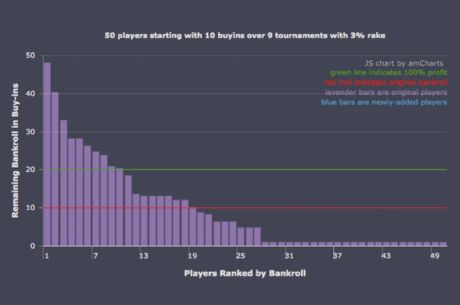The “Ten-to-One Rule” in Tournament Poker

For tournament players there is a useful idea worth knowing about that is often referred to as the “ten-to-one rule.” I’m not sure exactly where the idea originated, but I first learned of its existence through the Harrington On Hold’em book series by Dan Harrington and Bill Robertie. The concept applies to late tournament game play and is a fairly simple one.
The basis of the concept is rooted in the way cash prizes are awarded in tournaments and the pay jumps that occur after the money bubble bursts. Tournament payout structures are generally top-heavy, meaning that there is often a significant change in prize amounts the later the tourney is, especially at the final table.
With this notion in mind, the ten-to-one rule suggests that if you find yourself deep in a tournament and have at least 10 times the amount of chips that your opponent has, you should set your opponent all in with any two cards.
This is a recommended strategy for two different reasons. One is the fact that you could potentially eliminate your opponent if he calls and loses the hand. Secondly, there exists a strong possibility that the player will fold, allowing you to drag in another pot and pad your stack.
Let’s take a look at an example of the ten-to-one rule in action.
Say you’re at the final table of an event and just eight players remain. Blinds are 1,000/2,000 and you’re sitting pretty on a stack of 210,000. You are in the small blind and action folds around to you, and you look down to see an ugly 7♦2♣. Meanwhile your opponent is in the big blind and has just 20,000 in chips. Since pay jumps are most noticeable at the final table, the clear move here should be to set your opponent all in.
This is, of course, an aggressive action. Poker tends to favor aggressive actions because your opponent always has the option of letting go of his cards, allowing you to win the pot right away. At this stage in the game, your opponent will be trying to find a hand with which it seems worthy enough to risk his tournament life. If he looks down and sees a particularly weak hand — for example, 10♣4♠ — there’s a solid chance your opponent will toss his cards into the muck and you’ll pick up a pot, leaving him even shorter than before.
Of course such won’t always be the result. Sometimes your opponent will wake up with a strong hand and will be more than happy to call your shove. The beauty in this play, however, is that regardless of the strength of your opponent’s starting hand, he still will have to survive the five community cards in order to stay alive.
Let’s say you put an opponent all in with the aforementioned seven-deuce and he snaps you off, rolling over A♠K♥. Sure, it looks like you are in a disgusting position, but in actuality your meager preflop hand will still take down this pot about 33% of the time.
Ultimately with this move you are risking a minimal portion of your stack with the hopes of either winning a small pot or eliminating a player and moving up the pay ladder. But remember, it’s called the “ten-to-one rule” — in other words, for this to be a clear option, you need to have a large chip advantage over your opponent to perform the move.
Get all the latest PokerNews updates on your social media outlets. Follow us on Twitter and find us on both Facebook and Google+!








